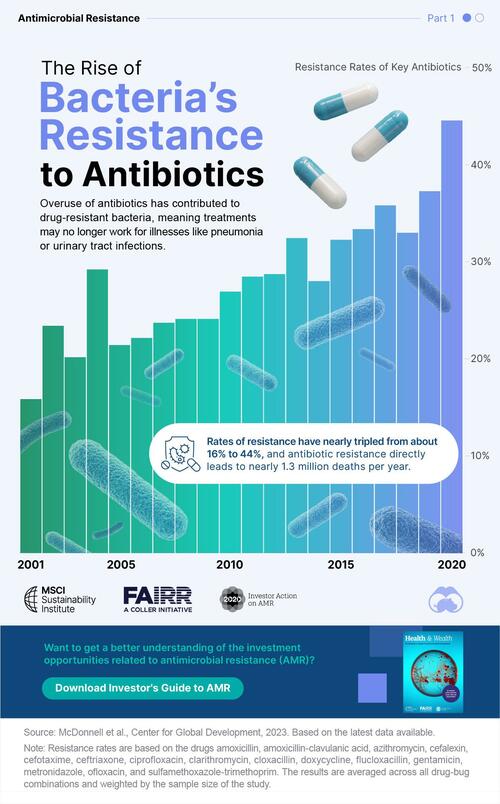Visualizing The Rise Of Antibiotic Resistance
Bacterial infections are becoming more dangerous.
When you’re fighting a bacterial infection, a doctor will typically prescribe you an antibiotic to help you recover. Unfortunately, rising antibiotic resistance means these drugs are becoming less effective.
In part one of this series on antimicrobial resistance, Visual Capitalist’s Jenna Ross partnered with the MSCI Sustainability Institute to highlight the increase in bacteria’s resistance to antibiotics.
What is Antibiotic Resistance?
Antibiotic resistance happens when bacteria evolve and become resistant to the drugs used to treat them. To some extent, this occurs naturally due to genetic changes in pathogens.
However, people have misused and overused drugs to prevent, control, and treat infections in humans, animals, and plants. This is the primary cause of more resistant bacteria.
Resistance Rates Over Time
Based on the latest available data, the resistance rates of key antibiotics increased from about 16% in 2001 to 44% in 2020. In other words, nearly half of infections are not responsive to the antibiotics typically used to treat them.
Unfortunately, the majority of experts believe that some of these key antibiotics—including amoxicillin and cephalexin, some of the most prescribed drugs in the U.S.—will very likely be lost to resistance within the next 15 years.
The Impact of Antibiotic Resistance
With treatments no longer working for illnesses like pneumonia or urinary tract infections in some cases, the risk of disease and death increases. Every year, antibiotic resistance directly leads to nearly 1.3 million deaths.
On top of this, rising resistance creates investment threats. For instance, companies failing to address antimicrobial resistance might face reputational damage. However, there are also opportunities for investors when it comes to the development of new antibiotics and alternative treatments.
In the second part of this series, we highlight the gap between infection-related deaths and research efforts.
Tyler Durden
Mon, 10/21/2024 – 20:30




Share This Article
Choose Your Platform: Facebook Twitter Linkedin